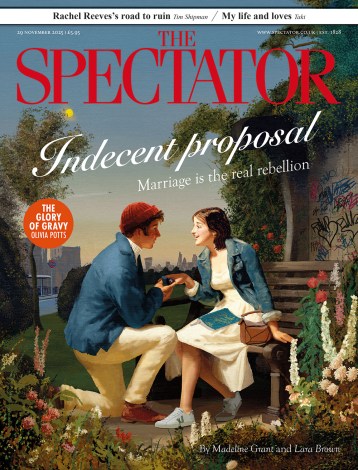Remember when history cost a few shillings? We wandered through romantic ruins, wondered who painted that dusty landscape above the fireplace, brushed lichen off carved stone and got shoes muddy spotting weeds in herbaceous borders. Visiting was about letting the quiet authority of age do its work; the place spoke for itself.
After a financially bruising encounter with a sequence of heritage attractions in the past month, I’ve realised this experience is no longer available in Britain. Accessing our history today means a digital entrance gate, a logo, a QR code and a moral message – plus a fee that makes your eyes water.
At St Paul’s Cathedral, the entry price for an adult is £26. A couple fork out £52 even before the gift shop. It cost £9 in 2007. Westminster Abbey is £31 – up from a tenner in 2007. York Minster, once a few coins at the door, now asks £20. Blenheim Palace has edged above £40, £9 more than a day pass to Alton Towers. Last week I dodged a £21 toll at Fountains Abbey by borrowing someone else’s National Trust membership card. I don’t feel guilt – I couldn’t have afforded to go otherwise.
Of course, we’ve heard each heritage organisation insist their repeated above-inflation price rises are necessary for conservation, energy bills and staff costs. It’s easy to puncture that: those rising costs include, for example, the National Trust’s new Head of Inclusion and Belonging, who is paid £40,342 for their 22.5-hour week, and the recently installed vegan tampon dispenser in the male toilets at Sizergh Castle in Cumbria.
But even if their whole huge turnover is wasted on head office salaries, daft woke-isms and political posturing, the effect is that our past has become a strangely premium product. Those who hold the keys have spoiled the experience and financed the whole enterprise by charging us extortionately.
My parents couldn’t afford foreign holidays but determinedly dragged this reluctant teen to British historic landmarks to acquire a lifetime’s respect and understanding of my country’s history – all for a few shillings and some peanut butter sandwiches in the car park. Even by 1990, a visit to a major heritage site averaged only around £2.50. But the shift to spend more, do more and present more has been relentless during my lifetime.
Today a Historic England survey puts the mean single admission at £12.42, rising to £17.49 in London. It’s £35.80 for one person to get into the Tower of London, £39 to Warwick Castle and £24 to St Michael’s Mount. Typical prices have risen by more than a quarter in the past three years. Those who decide them seem to target foreign tourists, the cluelessly wealthy and those given memberships of heritage associations as presents by someone who couldn’t think of anything else.
This month I faced a bill of more than £50 to take my daughter to two West Country ruins that don’t have a roof between them. They are essentially piles of old stones on grassy hilltops. What are their running costs?
The more exclusive these places become, the more affection the public withdraws. A castle that costs £40 to enter feels less like heritage and more like a theme park
Europe’s largest conservation charity, our own National Trust, seemingly leads the headlong charge to spend money to modernise the past. Once a charmingly eccentric society for enthusiasts of moss-covered abbeys and semi-erotic garden statuary, this vast corporate machine now owns more than 500 properties, has a turnover exceeding £700 million a year and cash reserves of a third of a billion.
Its prices continue to rise and its membership numbers continue to fall. Is it because ideology now comes with the ticket? Ruins are labelled and the past interpreted. You are directed where to stand, what to think and how to feel. The visit has a narrative that leans on modern political trends, particularly empire, class, climate and race. These are presented as compulsory sermons rather than background notes. The result is a sort of moral surcharge on top of the financial one.
Despite the Trust’s bizarre recent boast of ‘a boom in younger visitors’, the real historical trend has drifted elsewhere. For British youngsters it now seems to be all about stone circles, folklore, ancient footpaths and sacred sites. They’re massing at solstice hillforts, holy wells and standing stones for torchlit processions, makeshift Morris dancing and simply communing with it all. It’s uncurated, free and surely a reaction against a formal heritage that has been managed to death.
No one wants to pay extra for a ‘visitor journey’ with laminated explanations and interactive screens. We don’t need a ruin that ‘engages the visitor with questions of sustainability’, or a draughty mansion that ‘invites a conversation about privilege and the environment’. The head office instinct is always the same: raise prices, expand management, add another layer of interpretation – never to strip things back to what people actually loved.
These places belong, in theory, to everyone. But the more exclusive they become, the more affection the public withdraws. A castle that costs £40 to enter feels less like heritage and more like a theme park. The story these sites tell begins to sound less like history and more like PR for the establishment.
This ‘heritage industry’ spends plenty researching, displaying and glorifying the servants, serfs and slaves of history. Yet pensioners, the unemployed, students and hard-pressed families are priced out of their own story by organisations which appear to be treating us with all the elitist disdain of a Downton Abbey grandee.
Walk beneath the dome of St Paul’s and you still feel that shiver of space and time that no interpretive panel can improve. Step through the gilded gates of Blenheim and you sense the same blend of arrogance and brilliance that built it. That’s why people go. They don’t need to pay extra for an audio guide to tell them what they already feel. Each new generation should freely inherit the past. Now it’s as if we rent it by the hour.








Comments